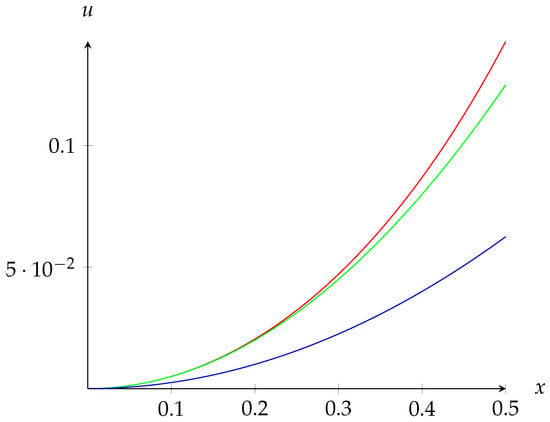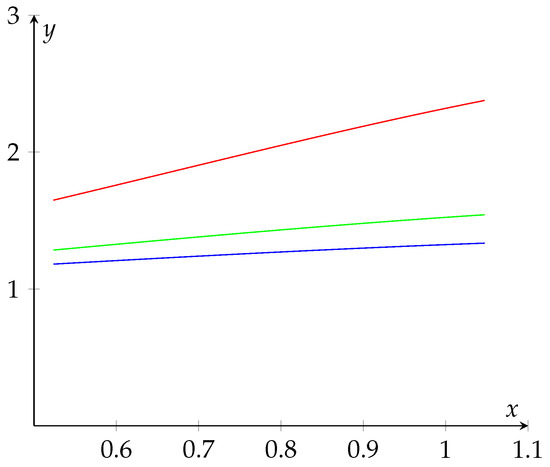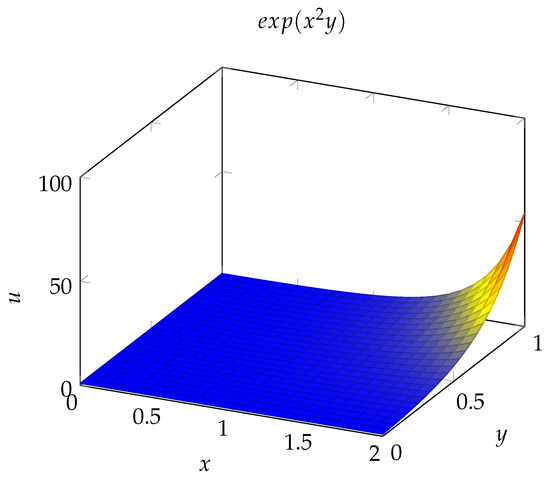Abstract
In this paper, we study some optimal inequalities of the Riccati type and of the Bihari type. We also consider nonoptimal inequalities of the Wendorf type. At the same time, we get a partial answer to Problems 5 and 9, formulated by I. A. Rus. This paper is also motivated by the fact that, in many inequalities, the upper bound is not an optimal one.
Keywords:
optimal Gronwall lemma; abstract Gronwall lemma; Picard operators; optimal Riccati type inequality; optimal Bihari type inequality; Wendorf type inequality MSC:
45G10; 45N05; 47N10
1. Introduction
Generally, inequalities have an important role in the development of all branches of mathematics—for instance, in differential and integral equations theory, partial differential equations theory, in the qualitative theory of differential equations, and stability theory. Many inequalities appear in modern science, in economical theory, in engineering, etc.
In what follows, we will consider some concrete optimal and nonoptimal Gronwall lemmas for differential equations and integral equations.
We will study inequalities of the form
where is a Picard operator and is an ordered L-space.
We first recall some notions and notations used in the paper. Let be the fixed points set of A. Let
Definition 1
([1]). Let X be a nonempty set. Let . Let be a subset of and be an operator. The triple is called an L-space (denoted by ) if the following conditions are satisfied:
- (i)
- if for all , then and ;
- (ii)
- if and , then, for all subsequences of , we have that and .
An element of ) is called a convergent sequence and is the limit of this sequence. We write or as
Definition 2
([2]). Let X be a nonempty set. is called an ordered L-space if:
- (i)
- is an L-space;
- (ii)
- is a partially ordered set;
- (iii)
- if and for each then .
Definition 3
([3]). Let be an ordered L-space. An operator is called a Picard operator if there exists such that and as for all
Now, we present Lemmas 1 and 2 in order to define the notion of optimal and nonoptimal lemmas. We follow the terminology and notation from [3,4,5].
Lemma 1.
(Abstract Gronwall Lemma [4,6]) (AGL). Let be an ordered L-space and an operator. We suppose that:
- (i)
- A is a Picard operator;
- (ii)
- A is an increasing operator.
If we denote by the unique fixed point of then we have:
Lemma 2.
(Abstract Gronwall Comparison Lemma [7]). Let be an ordered L-space and two operators. We suppose that:
- (i)
- A and B are Picard operators;
- (ii)
- A is an increasing operator;
- (iii)
- .
If we denote by the unique fixed point of A and by the unique fixed point of then
We can conclude, from Lemma 1, that is the upper optimal bound for the solutions of the inequality (1).
So, if we can determine the explicit form for , then we have a bound for the solutions of the inequality (1) and is the optimal bound. If the optimal bound cannot be derived explicitly or can not be found, then we apply Lemma 2 and the bound is not optimal but it is useful for applications. One of the most interesting nonoptimal inequalities is the Wendorff inequality (see Example 3).
In the paper [8], I. A. Rus proposed ten open problems regarding the theory of Gronwall lemmas. In this paper, we present some partial responses to Problems 5 and 9. We recall these problems bellow.
Problem 5. In which Gronwall lemmas are the upper bounds fixed points of the operator A?
Problem 9. Give new concrete and abstract Gronwall lemmas.
These problems were also studied by Craciun and Lungu in [4], Lungu and Rus [7], and Lungu and Ciplea [9].
2. Optimal Gronwall Lemmas
In this section, we consider some optimal lemmas, which are consequences of the Abstract Gronwall Lemma (AGL).
2.1. Optimal Riccati Type Inequality
In what follows, we present an upper bound of the solutions of the Riccati type inequality, which is the fixed point of the corresponding operator. Hence, we have an optimal Gronwall lemma.
In we consider the Bielecki norm:
For , let
We consider
Lemma 3.
We assume that:
- (i)
- (ii)
- and
- (iii)
- , where are such that:
Then:
- (a)
- there exists a unique solution of the equation (Riccati type equation):
- (b)
- if satisfies the inequalitythenwherein the interval whereand is a particular solution of the Riccati type equation
Proof.
(a) Let be the operator defined by:
From (iii), we have that , so the operator A is well defined.
The operator is increasing, by the assumption of (ii). Using conditions (i)–(iii), it follows that
Indeed, we have
Hence
We chose such that
thus, the operator A is a contraction, which implies that A is a Picard operator. Hence, there exists a unique solution to Equation (3).
(b) We determine the fixed point of the operator which is a solution of the equation for all This equation is equivalent to the following Cauchy problem:
Example 1.

We consider . If satisfies the inequality
then
where
is the solution of the Cauchy problem
For example, and satisfy inequality (7) and, geometrically, if we represent the functions and , we have that the graphs of are below (see Figure 1).

Figure 1.
Representation of the curves , which is the optimal solution (red color), (green color), (blue color), together on .
2.2. Optimal Bihari Type Inequality
In [4], an upper bound of the solutions of the Bihari inequality has been given, which is the fixed point of the corresponding operator.
Here, we will show that Lemma 2.2 from [4] is an optimal one. If we consider the inequality
where is continuous, positive, increasing and the Lipschitz function, then
where
If we consider where is the Bielecki norm and , the fixed point of the operator A is
Hence, the Bihari inequality is an optimal one.
Example 2.

We consider . If y satisfies the inequality
then
where
is the solution of the Cauchy problem
For example, and satisfy inequality (8) and, geometrically, we have that the graphs of are below (see Figure 2).

Figure 2.
Representation of the curves , which is the optimal solution (red color), (green color), (blue color), together on .
3. Nonoptimal Gronwall Lemmas
In some concrete Gronwall lemmas, only the following implication holds:
In this part we consider consequences of Lemma 2. We consider where and is the Bielecki norm on
Lemma 4.
(Wendorff type inequality) ([10,11,12,13,14]).
We assume that
- (i)
- (ii)
- v is increasing.
If satisfies
then
We consider the operator
This operator is an increasing Picard operator, but the function is not a fixed point of operator
Remark 1.
The right side of (9) is not a fixed point of operator A, so the concrete Lemma 4 is not a consequence of the abstract Gronwall Lemma 1.
Example 3.

We consider in the Wendorff inequality.
Let If satisfies
with conditions
then
In this case, the corresponding operator is
and the function is not a fixed point of operator However, we remark that is a fixed point of operator
hence, here, Lemma 2 is applied. We have
where and is the fixed point of operator A. Geometrically, the surface , represented in Figure 3, is above the surface corresponding to the optimal solution , which cannot be explicitly derived.

Figure 3.
Representation of the surface on .
Example 4.
We consider the inequality (see [15])
where u is a continuous and positive function for all and K is of class after x and continuous after for and
Then,
In this case, operator A is
We remark that the function
is not the fixed point of operator A; therefore, inequality (11) is nonoptimal.
Remark 2.
For other examples in this direction, see [15,16,17,18,19,20,21,22,23,24].
4. Conclusions
In this paper, we studied concrete optimal Gronwall lemmas corresponding to Riccati and Bihari type inequalities and nonoptimal Gronwall lemmas corresponding to Wendorf type inequalities. Moreover, we obtained a partial response to Problems 5 and 9, formulated by I. A. Rus in [8]. Some geometrical meanings were also given. In the case containing the functions of one variable, where optimal Gronwall lemmas were applied, the curve corresponding to every solution of the given inequality was below the curve corresponding to the optimal solution. In the case containing the functions of two variables, the surface corresponding to each solution of the given inequality was below the surface of the corresponding optimal solution.
Author Contributions
Conceptualization, D.M., S.A.C. and N.L.; investigation, D.M., S.A.C. and N.L.; writing—original draft preparation, D.M.; writing—review and editing, D.M. and S.A.C. All authors have read and agreed to the published version of the manuscript.
Funding
This research received no external funding.
Conflicts of Interest
The authors declare no conflict of interest.
References
- Fréchet, M. Les Espaces Abstraits; Gauthier-Villars: Paris, France, 1928. [Google Scholar]
- Petrusel, A.; Rus, I.A. Fixed point theorems in ordered L-spaces. Proc. Am. Math. Soc. 2009, 134, 411–418. [Google Scholar] [CrossRef]
- Rus, I.A. Picard operators and applications. Sci. Math. Jpn. 2003, 58, 191–219. [Google Scholar]
- Craciun, C.; Lungu, N. Abstract and concrete Gronwall lemmas. Fixed Point Theory 2009, 10, 221–228. [Google Scholar]
- Rus, I.A. Weakly Picard operators and applications. Semin. Fixed Point Therory 2001, 2, 48–51. [Google Scholar]
- Rus, I.A. Gronwall Lemma Approach to the Hyers-Ulam-Rassias Stability of an Integral Equation. In Nonlinear Analysis and Variational Problems; Springer: New York, NY, USA, 2010; Volume 35, pp. 147–152. [Google Scholar]
- Lungu, N.; Rus, I.A. Gronwall inequalities via Picard operators. An. Stiint. Univ. Al. I. Cuza Iasi. Sect. I Mat. 2012, LVIII, 269–278. [Google Scholar] [CrossRef]
- Rus, I.A. Gronwall Lemmas: Ten open problems. Sci. Math. Jpn. 2009, 70, 221–228. [Google Scholar]
- Lungu, N.; Ciplea, S.A. Optimal Gronwall lemmas. Fixed Point Theory 2017, 18, 293–304. [Google Scholar] [CrossRef][Green Version]
- Garcia-Falset, J.; Reich, S. Integral solutions to a class of nonlocal evolution equations. Commun. Contemp. Math. 2010, 12, 1031–1053. [Google Scholar] [CrossRef]
- Lakshmikantham, V.; Leela, S.; Martynyuk, A.A. Stability Analysis of Nonlinear Systems; Marcel Dekker, Inc.: New York, NY, USA, 1989; Volume 125. [Google Scholar]
- Lungu, N. On some Volterra integral inequalities. Fixed Point Theory 2007, 8, 39–45. [Google Scholar]
- Mitrinovič, D.S.; Pečarič, J.E.; Fink, A.M. Inequalities Involving Functions and Their Integrals and Derivatives; Kluwer: Dordrecht, The Netherlands, 1991. [Google Scholar]
- Pachpatte, B.G. Inequalities for Differential and Integral Equations; Academic Press: New York, NY, USA; London, UK, 1998. [Google Scholar]
- Martynyuk, A.A.; Lakshmikantham, V.; Leela, S. Stability of Motion: Method of Integral Inequalities; Nauk Dumka: Kiev, Ukraine, 1989. [Google Scholar]
- Bainov, D.; Simeonov, P. Integral Inequalities and Applications; Kluwer Academic Publishers Group: Dordrecht, The Netherlands, 1992. [Google Scholar]
- Lungu, N. On some Gronwall-Bihari-type inequalities. Lib. Math. 2000, 20, 67–70. [Google Scholar]
- Lungu, N. On some Gronwall-Bihari-Wendorff-type inequalities. Semin. Fixed Point Therory 2002, 3, 249–254. [Google Scholar]
- Lungu, N.; Craciun, C. Pseudo-parabolic inequalities. Carpathian J. Math. 2011, 27, 201–207. [Google Scholar]
- Lungu, N.; Popa, D. On some differential inequalities. Semin. Fixed Point Therory 2002, 3, 323–327. [Google Scholar]
- Lungu, N.; Rus, I.A. On a functional Volterra-Fredholm integral equation, via Picard operators. J. Math. Ineq. 2009, 41, 519–527. [Google Scholar] [CrossRef]
- Rus, I.A. The theory of a metrical fixed point theorem: Theoretical and applicative relevance. Fixed Point Theory 2008, 9, 541–559. [Google Scholar]
- Rus, I.A. Abstract Gronwall lemmas and applications. Carpathian J. Math. 2004, 20, 125–134. [Google Scholar]
- Rus, I.A. Generalized Contractions and Applications; Cluj University Press: Cluj-Napoca, Romania, 2011. [Google Scholar]
Publisher’s Note: MDPI stays neutral with regard to jurisdictional claims in published maps and institutional affiliations. |
© 2020 by the authors. Licensee MDPI, Basel, Switzerland. This article is an open access article distributed under the terms and conditions of the Creative Commons Attribution (CC BY) license (http://creativecommons.org/licenses/by/4.0/).